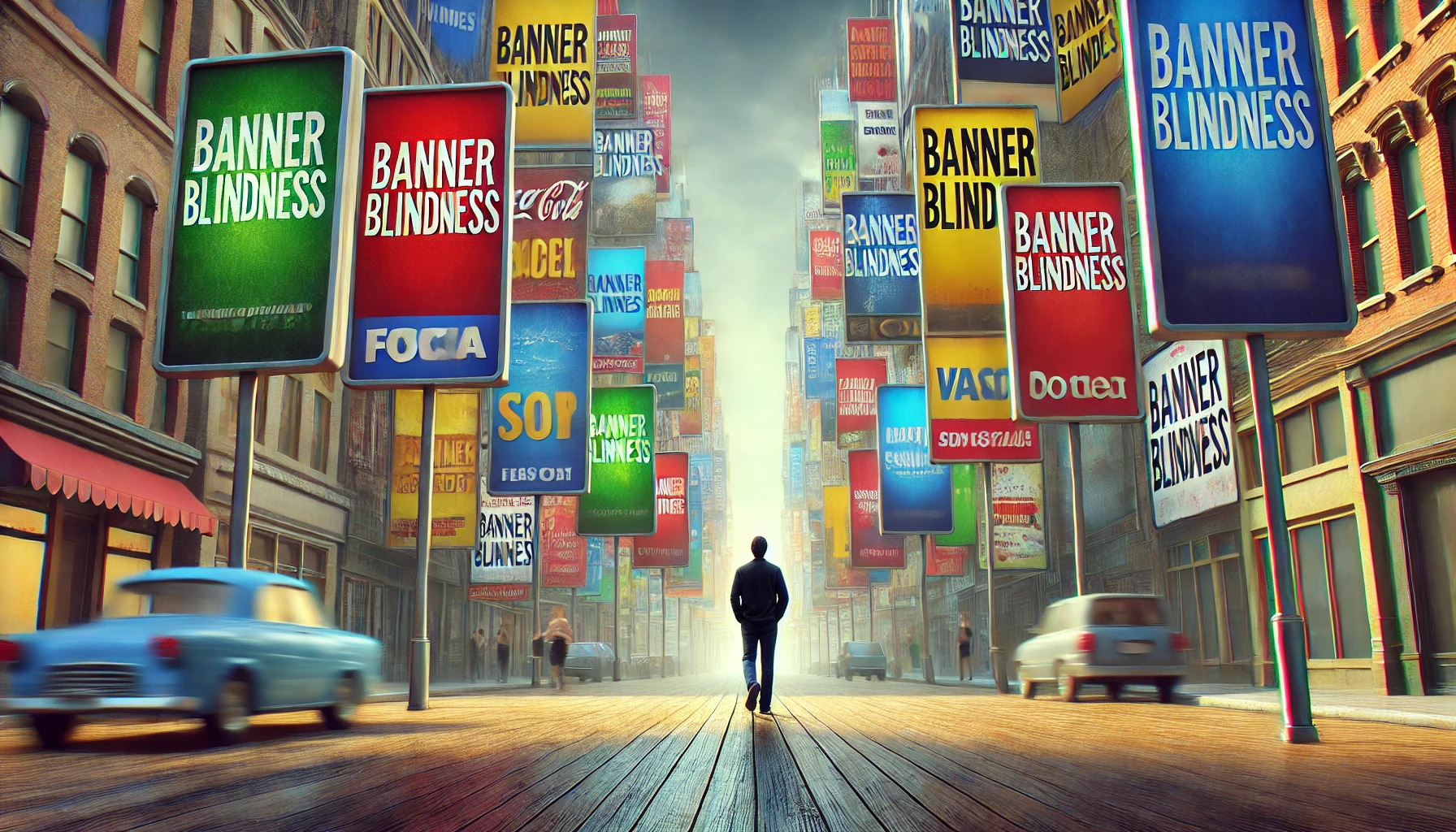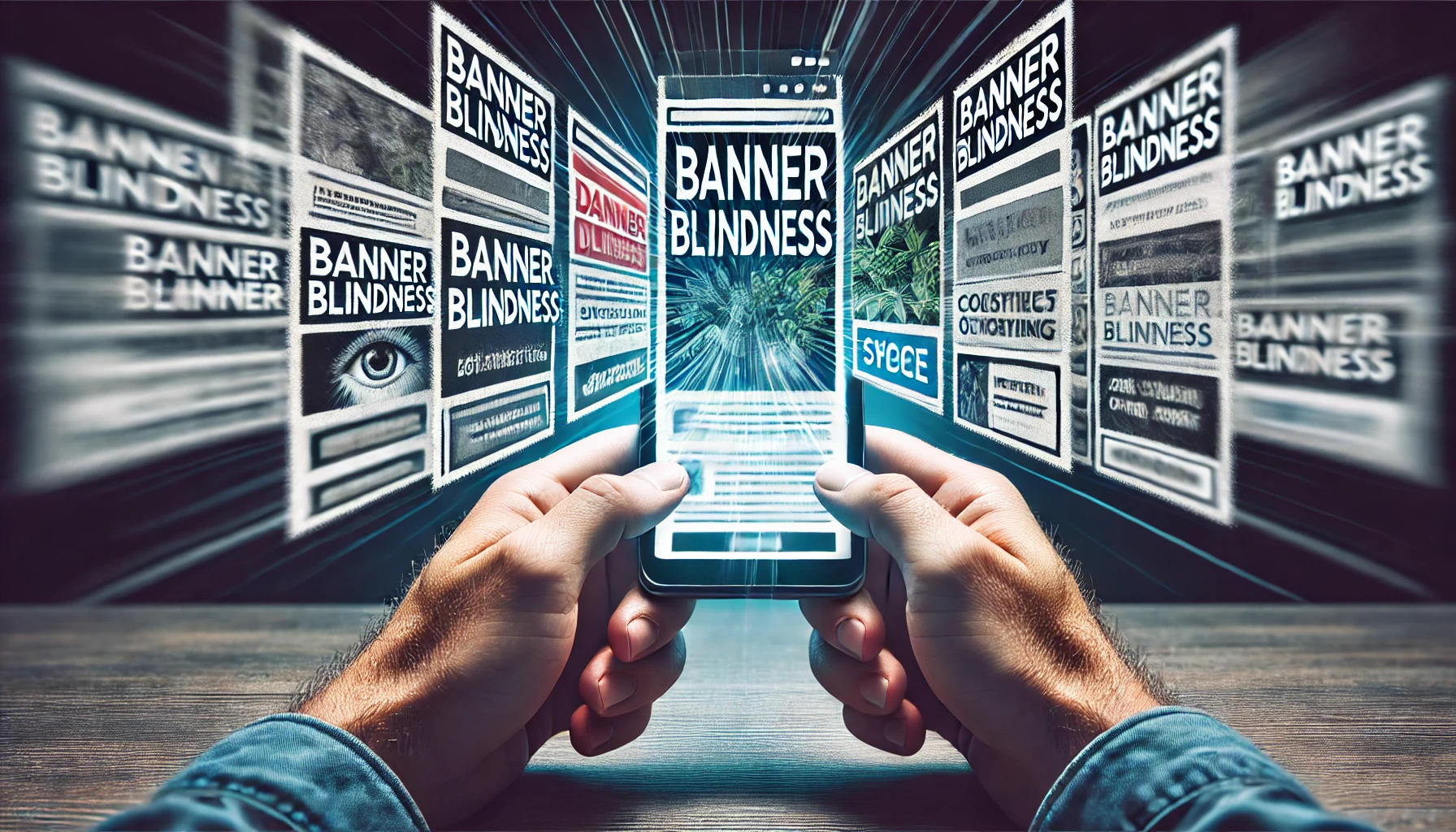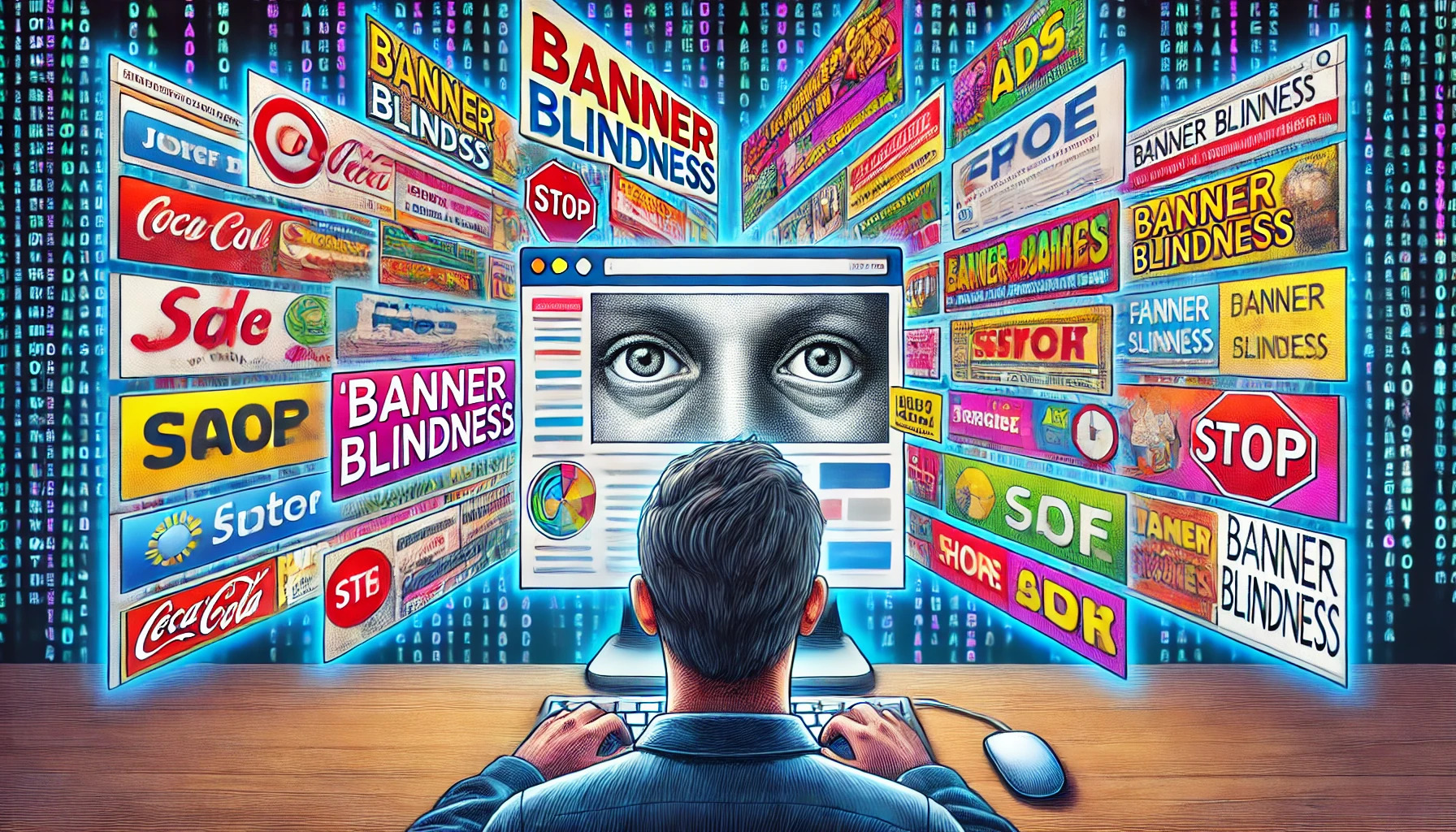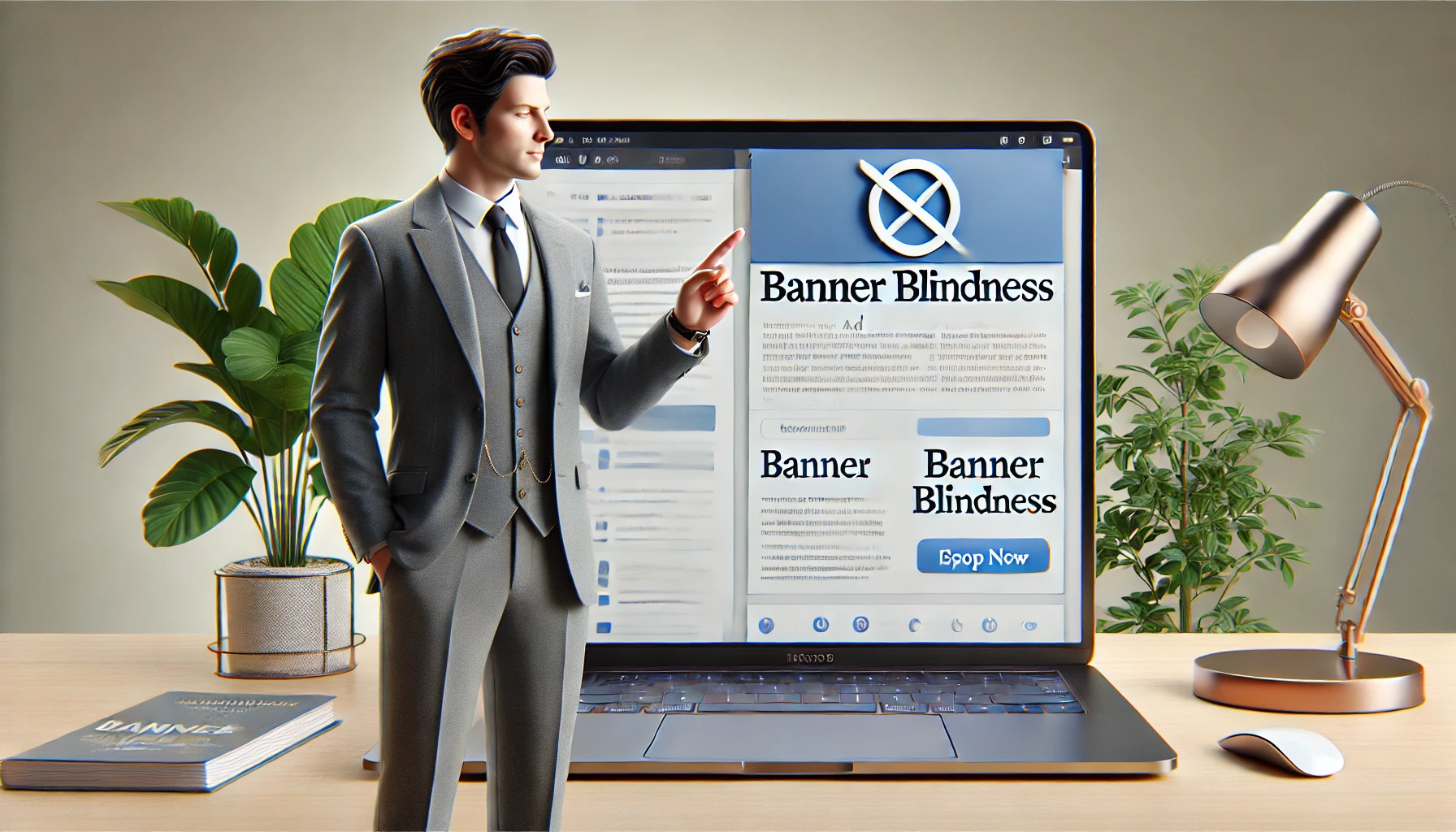This article, produced by the Research and Development unit of FLEXINEXA, delves into the phenomenon of banner blindness and its impact on online marketing. Banner blindness refers to the situation where website users unconsciously or deliberately ignore banner ads. This phenomenon has become a major challenge in digital advertising, with its negative effects on the success of advertising campaigns being undeniable.

In this article, we will explore the factors contributing to banner blindness and its impact on user engagement, click-through rate, and web usability. Additionally, we will discuss effective advertising strategies and visual design techniques to combat this issue. The goal of this article is to provide practical solutions for increasing user attention to ads and improving the performance of online advertisements, enabling businesses to achieve greater success in their online marketing efforts.
What is Banner Blindness?
Banner blindness refers to a situation where individuals, either unconsciously or deliberately, ignore banner advertisements while browsing websites. This means that even though banner ads are visually present on a webpage, many users fail to notice or pay attention to them. Over time, users have become accustomed to seeing banner ads, and their brains automatically filter them out as non-essential information. This phenomenon leads to banner ads having less impact on the audience, reducing user engagement and click-through rates.
Banner blindness is rooted in cognitive and psychological processes. When users encounter large volumes of information in online environments, their brains instinctively filter out unnecessary content. This process acts as a defensive mechanism to prevent information overload. As a result, users often ignore banner ads that are placed alongside the main content of the page.
From a scientific perspective, over time, the brain learns to recognize repetitive and static elements like banner ads and categorizes them as irrelevant. Consequently, users pay less attention to them, even if the ads are visually prominent. This mechanism becomes a cognitive habit that stems from the brain’s effort to conserve energy and focus on more important information.
Additionally, standardized and repetitive designs of banners play a crucial role in reinforcing this habit. Users quickly recognize similar advertising structures and skip over them, even if the content of the ad is engaging or useful.
Thus, banner blindness is the result of a complex interaction between cognitive habits and the filtering of unnecessary information, gradually forming in users’ minds over time.

Factors Influencing Banner Blindness
High Volume of Advertisements
When users encounter a large number of ads on a webpage, the likelihood of banner blindness increases. This happens because the human brain automatically filters out unimportant or repetitive content to focus on the main information. Excessive ads can cause users to ignore them altogether, directly reducing the click-through rate.
Repetitive and Unattractive Design
One of the major causes of banner blindness is the repetitive and uniform design of banner ads. When all ads are designed similarly, users quickly recognize and overlook them. Weak or clichéd designs result in users ignoring the ads, reducing user engagement with the ad content.
Placement of Advertisements
The placement of ads on a webpage plays a crucial role in banner blindness. If ads are placed in predictable locations such as at the top of the page or in the sidebar, users are more likely to ignore them automatically. Ads should be placed in unexpected locations, close to the main content, to improve web usability and capture users’ attention.
Irrelevant Content
If ads are not aligned with the main content of the page, users will filter them out more quickly. Targeted ads that are relevant to users’ needs and interests are more likely to attract attention and increase the click-through rate.
Slow Ad Loading
If ads do not load properly or quickly, users are likely to ignore them or even leave the page. Fast and optimized ad loading can be effective in drawing users’ attention and enhancing the user experience.
Effects of Banner Blindness on:
- User Engagement: Banner blindness causes users to engage less with advertisements as their brains automatically filter them out. This reduces user interaction with brands and decreases the likelihood of purchases or further exploration.
- Click-through Rate: One of the primary consequences of banner blindness is a significant drop in click-through rates. Ads that are ignored fail to generate the expected clicks, directly affecting the performance of advertising campaigns.
- Web Usability: Banner blindness can negatively impact web usability, as irrelevant or ineffective ads lead to user fatigue and confusion. However, well-designed and strategically placed ads can enhance the user experience and even improve web usability.
 Effective Advertising Strategies and Visual Design to Combat Banner Blindness:
Effective Advertising Strategies and Visual Design to Combat Banner Blindness:
Native Ads:
Native ads blend seamlessly into the main content of a page, appearing more natural and less intrusive. Instead of forcefully grabbing attention, these ads align with the site’s content, making them less prone to banner blindness. Native ads can effectively boost user engagement and increase click-through rates.
Creative and Unique Design:
Using creative and unexpected designs that differ from standard banner formats can attract users’ attention. Visual designs that incorporate attractive colors, subtle animations, and interactive elements are far more effective. The design should be simple yet stand out from common clichés to capture attention.
Short Video Ads:
Short video ads are an effective method to combat banner blindness. They are generally more engaging than static banners and can prompt users to pause and watch. However, the video should be brief, useful, and relevant to the user’s needs.
Changing Ad Placement:
Selecting the right placement for ads is crucial. Ads shouldn’t be limited to fixed, predictable spots like the top of the page or the sidebar. Placing ads in more unexpected areas, such as within the main content or between paragraphs, can have a greater impact on catching the user’s attention.
Targeted Advertising:
Ads should be targeted and aligned with the interests and needs of the users. Using behavioral data to present relevant ads at the right time and place can enhance the effectiveness of ads and reduce banner blindness.
Interactive Offers:
Adding interactive elements like polls, games, or other engaging features within ads can capture user attention and encourage interaction. These methods not only increase user engagement but also provide a sense of control and choice for the users.
A/B Testing:
Using A/B testing to compare the performance of different ad designs and placements can help improve results. Through testing various versions, the best-performing design and placement can be identified, reducing the likelihood of banner blindness.
Use of White Space:
Surrounding ads with white space helps guide the user’s eyes naturally toward them. This technique prevents ads from getting lost amidst other content on the page and increases their visibility.
Responsive Design:
Ensuring that ads are displayed correctly across all devices is essential. Ads must be optimized for smartphones, tablets, and desktops to create a seamless user experience and reduce banner blindness on any device.
Fast Loading and Ad Optimization:
Ads that load quickly and are lightweight have a higher chance of being viewed. Slow-loading ads can frustrate users and lead to them ignoring the ad. Therefore, optimizing ads for fast loading is a key factor in combating banner blindness.
These strategies and visual designs can help reduce banner blindness, improving both click-through rates and user engagement.

Banner blindness has become a significant challenge in the world of digital advertising. As users increasingly ignore banners due to repetitive designs and ad overload, it is essential to adopt creative strategies and smart visual design to turn this challenge into an opportunity.
By employing native ads, creative and unique designs, short video ads, and targeted advertising, businesses can reduce the impact of banner blindness. Additionally, A/B testing, the use of white space, and optimizing ad load times can effectively capture users’ attention and improve click-through rates.
In conclusion, responsive design and strategic ad placement are also key factors that enhance user experience and boost ad performance. By implementing these strategies, businesses can not only combat banner blindness but also leverage their ads to attract a larger audience and increase user engagement.
___________________________________________________________________________
FAQ
- What is Banner Blindness, and how does it occur?
Banner blindness refers to the phenomenon where users, either unconsciously or deliberately, ignore banner ads while browsing websites. This happens because users become accustomed to seeing banners, and their brains automatically filter out this content to focus on the main information.
- How does banner blindness affect online marketing?
Banner blindness directly reduces user engagement and the click-through rate in digital advertising campaigns. When users ignore banner ads, businesses fail to achieve the desired results from their advertising strategies, negatively impacting online marketing efforts.
- What factors contribute to banner blindness?
Several factors contribute to banner blindness, including a high volume of ads on web pages, repetitive and unattractive designs, and poor ad placement. These factors lead users to unconsciously filter out the ads and pay no attention to them.
- How can banner blindness be overcome?
To combat banner blindness, using creative and unique designs, native ads that align with the website’s content, and targeted advertising can be effective. Additionally, placing ads in unexpected areas and improving visual design can help capture users’ attention.
- How does banner blindness affect click-through rates?
Banner blindness directly reduces the click-through rate, as users unconsciously avoid clicking on ads. This causes the ads to underperform, leading to lower interaction and engagement with the advertised content.
- Does ad placement on a website impact banner blindness?
Yes, ad placement is a key factor in banner blindness. Ads placed in predictable locations, such as the top of the page or the sidebar, are often ignored by users. Placing ads in unexpected areas, close to the main content, can help improve web usability and capture attention.
- Can responsive design help reduce banner blindness?
Yes, responsive design that ensures ads display correctly on all devices, including smartphones, tablets, and desktops, can help reduce banner blindness. It improves the user experience and increases the likelihood of interaction with the ads.
- What is the impact of banner blindness on web usability?
Banner blindness can negatively affect web usability, as irrelevant or ineffective ads can lead to user frustration and confusion. On the other hand, well-targeted and relevant ads can improve the user experience and encourage interaction with the website.
- Can A/B testing help reduce banner blindness?
Yes, A/B testing is an effective method for reducing banner blindness. By testing different versions of ads and their placements, businesses can determine which design and location attract the most attention and yield the best results.
- How can visual design improve click-through rates?
Creative visual design can significantly improve click-through rates. Using attractive colors, sufficient white space, and interactive elements in ads can grab users’ attention and encourage them to click on the ad.















